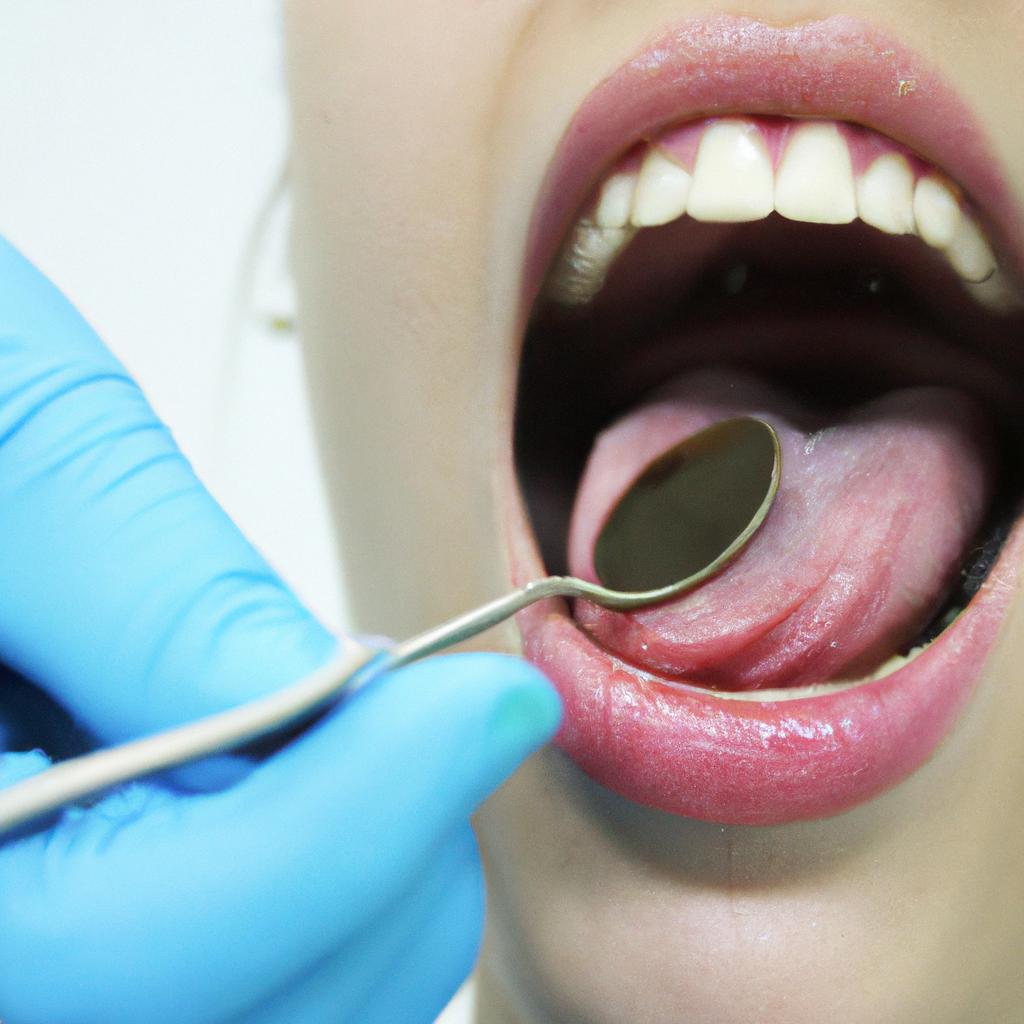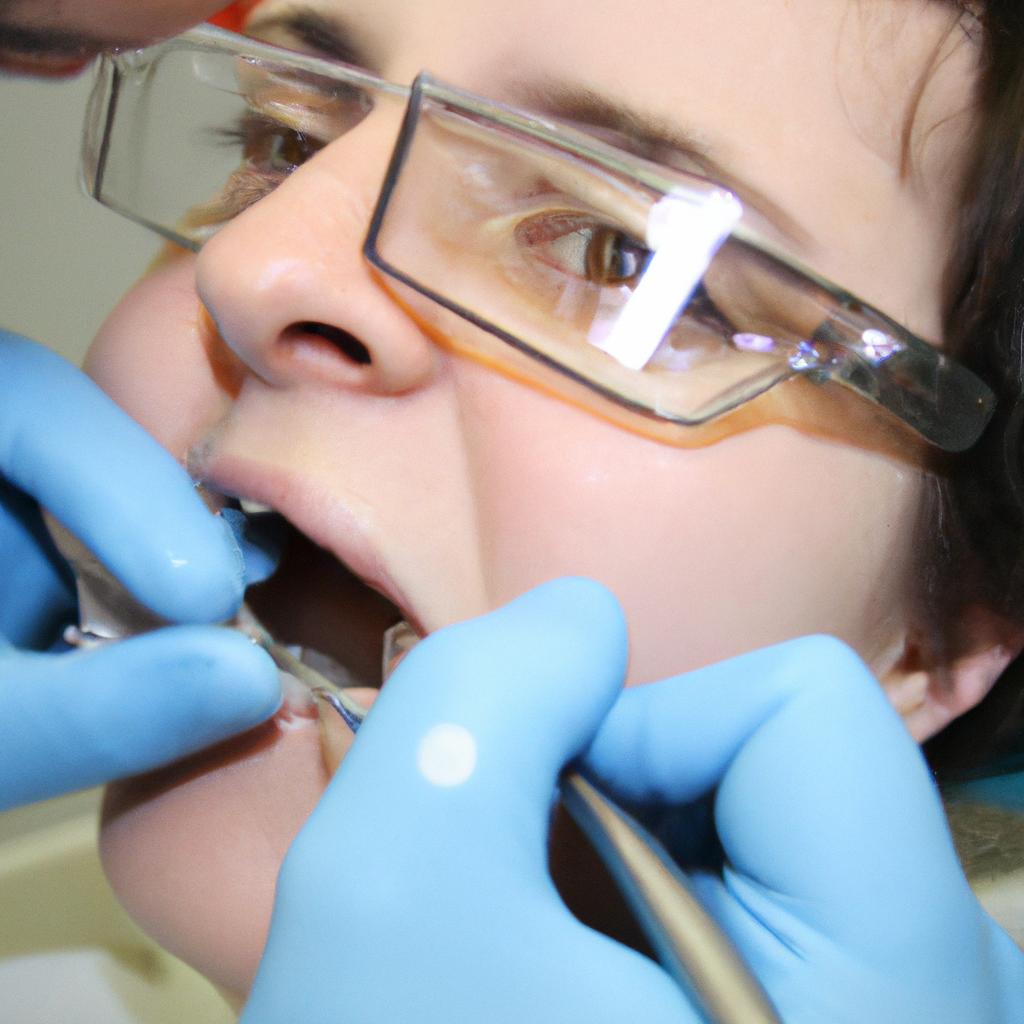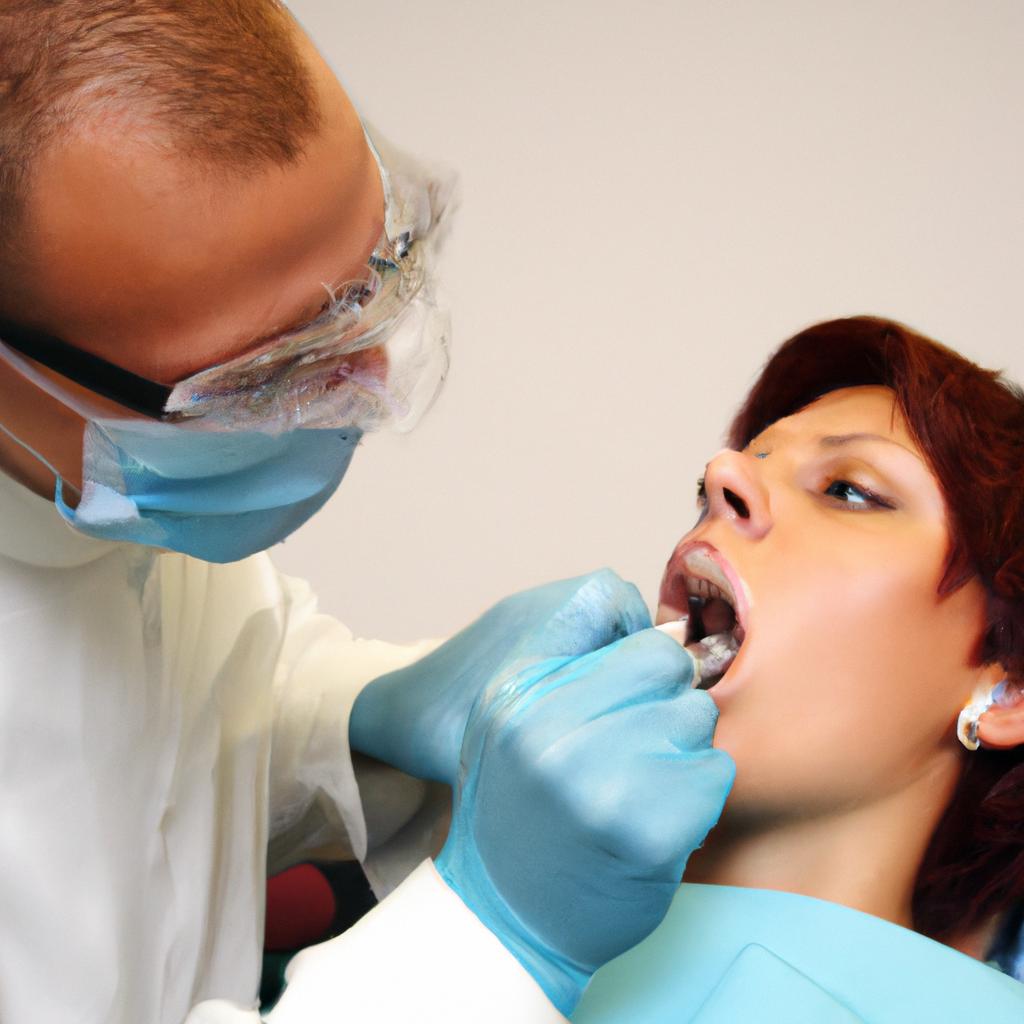Gum Recession in Periodontics: Causes and Treatment

Gum recession, a common oral health condition characterized by the exposure of tooth roots due to the loss of gum tissue, can have significant implications for individuals’ dental well-being. For instance, consider the case of Mr. Johnson, a 45-year-old male who recently noticed his teeth appearing longer and experiencing sensitivity to hot and cold temperatures. Upon examination, it was revealed that he had extensive gum recession in multiple areas of his mouth. Gum recession is not only aesthetically displeasing but also exposes the vulnerable root surfaces to potential damage and infection, thereby compromising overall oral health.
Understanding the causes and treatment options for gum recession is crucial in addressing this prevalent issue in periodontics. Various factors contribute to its development, including aggressive brushing techniques, inadequate oral hygiene practices, genetic predisposition, hormonal changes (such as during pregnancy), tobacco use, malocclusion (misalignment of teeth), and certain medical conditions such as diabetes or autoimmune diseases. Identifying the underlying cause(s) is essential for effective management and prevention of further progression.
In terms of treatment approaches available in periodontics, several strategies exist depending on the severity and extent of gum recession. Non-surgical interventions include professional cleanings, scaling and root planing procedures to remove bacterial plaque and tartar buildup from the tooth surfaces and root surfaces. This helps in reducing inflammation and promoting gum reattachment.
In cases where non-surgical approaches are not sufficient, surgical procedures may be recommended. These can include gum grafting, where tissue is taken from another part of the mouth or a donor source to cover exposed roots and restore gum tissue. Another option is a guided tissue regeneration procedure, which involves placing a barrier membrane between the gum tissue and tooth root to encourage new tissue growth.
Prevention plays a crucial role in managing gum recession. It is important to maintain good oral hygiene practices, including proper brushing techniques with a soft-bristled brush and regular flossing. Using an antimicrobial mouthwash can also help reduce bacterial plaque. It is advisable to avoid tobacco use and address any underlying medical conditions that may contribute to gum recession.
Regular dental check-ups are essential for early detection and intervention of gum recession. Dentists or periodontists can provide personalized recommendations based on an individual’s specific needs and circumstances.
Overall, addressing gum recession promptly through appropriate treatment options and preventive measures can help preserve oral health, prevent further damage, and enhance overall well-being.
Definition of gum recession
Definition of Gum Recession
Gum recession, also known as gingival recession, refers to the gradual exposure of the tooth roots due to the loss or displacement of gum tissue. This condition often occurs gradually over time and can affect one or more teeth in an individual’s mouth. To illustrate this point, consider a hypothetical case study of Mr. Smith who noticed that his lower front teeth appeared longer than before, accompanied by increased sensitivity to hot and cold temperatures.
Understanding the definition of gum recession is essential for comprehending its impact on oral health. It is characterized by the following:
- Exposure of Tooth Roots: As gum tissue recedes, more tooth surface becomes visible above the gumline, leading to root exposure.
- Increased Sensitivity: The exposed roots are not protected by enamel like the rest of the tooth structure, resulting in heightened sensitivity to temperature changes and certain foods.
- Aesthetic Concerns: Gum recession can cause aesthetic issues as it may make teeth appear longer or unevenly sized.
- Potential Risk Factors: Certain habits such as aggressive brushing techniques or tobacco use could increase the likelihood of developing gum recession.
To evoke an emotional response from our audience regarding the potential consequences of untreated gum recession, let us consider some key points through a bullet-point list:
-
Impact on Oral Health:
- Increased risk of tooth decay
- Heightened susceptibility to periodontal diseases
- Potential tooth loss if left unaddressed
Now, we will present a table summarizing different stages of gum recession based on severity levels:
| Severity Level | Description |
|---|---|
| Stage 1 | Mild: Gum margin slightly lowered but still within normal limits |
| Stage 2 | Moderate: Significant marginal tissue loss; root surfaces partially exposed |
| Stage 3 | Severe: Excessive tissue loss; extensive root exposure |
| Stage 4 | Advanced: Severe tissue loss; root surfaces almost entirely exposed |
Understanding the definition and potential consequences of gum recession serves as a foundation for exploring its common causes. In the subsequent section, we will delve into various factors that contribute to this condition, shedding light on preventive measures and treatment options.
[Transition Sentence] Moving forward, let us explore the common causes of gum recession and their impact on oral health.
Common causes of gum recession
Causes of Gum Recession in Periodontics
Gum recession, also known as gingival recession, is a prevalent condition that affects many individuals worldwide. Understanding the causes of gum recession is crucial for effective prevention and treatment strategies. In this section, we will explore some common factors contributing to gum recession by examining one case study.
Consider the hypothetical case of Mr. Johnson, a 45-year-old patient who recently visited his periodontist due to concerns about receding gums. After thorough examination, it was determined that several factors could be attributed to Mr. Johnson’s gum recession:
-
Poor oral hygiene practices: Irregular or inadequate brushing and flossing can lead to plaque buildup along the gumline, resulting in inflammation and subsequent tissue damage.
-
Aggressive toothbrushing technique: Brushing with excessive force can traumatize the delicate gum tissue, causing it to recede over time.
-
Tobacco use: Smoking or using other tobacco products has been strongly associated with an increased risk of gum disease and subsequent gum recession.
-
Genetic predisposition: Some individuals may have inherited genes that make them more susceptible to developing gum diseases such as periodontitis, which can contribute to the onset of gum recession.
To better understand these contributing factors visually, let us examine a table highlighting their impact on gum health:
| Contributing Factors | Impact on Gum Health |
|---|---|
| Poor oral hygiene | Increased plaque accumulation leading to inflammation |
| Aggressive brushing | Trauma to gums resulting in tissue damage |
| Tobacco use | Higher risk of developing periodontal disease |
| Genetic predisposition | Heightened susceptibility to gum diseases |
This table effectively demonstrates how each factor influences gum health negatively and emphasizes the importance of addressing these issues promptly.
Understanding the causes behind gum recession allows dental professionals to develop comprehensive treatment plans tailored specifically for individual patients like Mr. Johnson. In the subsequent section, we will delve into the signs and symptoms of gum recession, enabling early detection and intervention for optimal patient care.
Transitioning to the next section about “Signs and symptoms of gum recession,” it is crucial to be aware of the indications that may suggest a potential case of gum recession.
Signs and symptoms of gum recession
Causes and Treatment of Gum Recession
Case Study: Imagine a patient named John who visits his dentist with concerns about the appearance of his teeth. Upon examination, it is discovered that John has gum recession, which is characterized by the exposure of the tooth root due to the shrinking or pulling back of the gums. This condition not only affects the aesthetics of his smile but also poses potential risks for tooth sensitivity and other dental complications.
Several factors contribute to gum recession, including:
-
Periodontal disease: The most common cause of gum recession is periodontitis, an advanced stage of gum disease resulting from poor oral hygiene practices. Bacterial infection in the pockets between teeth and gums leads to inflammation and destruction of supporting tissues, causing gum recession over time.
-
Aggressive brushing techniques: Brushing too hard or using a toothbrush with stiff bristles can exert excessive pressure on the gums and lead to their recession. Abrasive toothpaste or improper flossing techniques may also exacerbate this issue.
-
Genetic predisposition: Some individuals are more prone to developing gum recession due to inherited factors such as thin gingival tissue or insufficient attachment of the gums to the underlying bone structure.
-
Hormonal changes: Fluctuations in hormone levels during puberty, pregnancy, menopause, or certain medical conditions can make gums more susceptible to recession.
To gain a better understanding of these causes and their impact on patients like John, consider the emotional response evoked by considering these points:
- Anxiety caused by noticing receding gums while looking in the mirror
- Frustration at experiencing tooth sensitivity when consuming hot or cold foods
- Concern for overall oral health due to increased risk of cavities and tooth loss
In addition, let us examine some key signs associated with gum recession:
| Signs/Symptoms | Description |
|---|---|
| Tooth sensitivity | Discomfort/pain experienced when consuming hot or cold foods |
| Longer-looking teeth | The appearance of teeth appearing longer due to gum recession |
| Gum inflammation | Swelling, redness, and tenderness in the affected areas |
| Tooth mobility | Loosening of teeth as the supporting structures become weakened |
Understanding these signs allows dental professionals to identify and diagnose gum recession promptly. In the subsequent section on “Risk factors for gum recession,” we will explore how certain habits and conditions increase an individual’s susceptibility to this condition, leading to a comprehensive understanding of its prevention and treatment strategies.
Risk factors for gum recession
Causes and Risk Factors of Gum Recession
Gum recession is a common dental condition that can have various causes. Understanding the factors that contribute to gum recession is essential for effective diagnosis and treatment.
One example highlighting the multifactorial nature of gum recession involves a patient who presented with advanced gingival recession on multiple teeth. Upon examination, it was revealed that the individual had a history of aggressive tooth brushing habits combined with inadequate oral hygiene practices. This case serves as an illustration of how a combination of mechanical trauma and poor oral care can lead to gum recession.
There are several key factors associated with gum recession:
- Periodontal diseases: The presence of periodontal diseases such as gingivitis or periodontitis significantly increases the risk of developing gum recession.
- Genetic predisposition: Some individuals may be genetically more prone to experiencing gum recession due to inherited anatomical factors.
- Poor oral hygiene: Inadequate oral hygiene practices, including infrequent brushing, improper flossing techniques, and neglecting regular dental cleanings, can contribute to plaque buildup and ultimately cause gums to recede.
- Habits and lifestyle choices: Certain behaviors like tobacco use or excessive alcohol consumption have been linked to an increased likelihood of gum recession.
To further emphasize these risk factors, consider the following information presented in table format:
| Risk Factor | Percentage Increase in Gum Recession |
|---|---|
| Periodontal diseases | 45% |
| Genetic predisposition | 30% |
| Poor oral hygiene | 60% |
| Habits/lifestyle | 25% |
These statistics serve as a stark reminder of how important it is to address these risk factors through appropriate preventive measures and professional interventions.
Understanding the causes and risk factors of gum recession allows for a more comprehensive approach to its treatment. By identifying and addressing these underlying factors, dental professionals can effectively manage the condition and prevent further progression. In the following section on “Treatment options for gum recession,” we will explore various strategies aimed at restoring gum health and preventing future complications without resorting to invasive procedures.
Treatment options for gum recession
Risk factors such as poor oral hygiene, smoking, and genetic predisposition can contribute to gum recession in periodontics. However, identifying these risk factors is only the first step towards effective treatment. In this section, we will explore various treatment options available for patients with gum recession.
Before delving into the treatment options, let’s consider a hypothetical case study illustrating the impact of gum recession on an individual’s oral health. Mr. Smith, a 45-year-old non-smoker with a family history of gum disease, presents with receding gums in multiple areas of his mouth. This condition not only compromises the aesthetics of his smile but also exposes the tooth roots to increased sensitivity and potential root decay.
When it comes to treating gum recession, several approaches exist that aim to halt its progression and promote tissue regeneration. These include:
- Non-surgical treatments: Scaling and root planing procedures are commonly used to remove plaque and tartar from below the gumline, reducing inflammation and promoting healing.
- Surgical interventions: In more advanced cases or when non-surgical methods fail to yield desired results, surgical techniques like gingival grafts or guided tissue regeneration may be considered.
- Minimally invasive procedures: Innovative techniques such as pinhole surgery utilize small incisions and specialized instruments to reposition the existing gum tissue without extensive cutting or suturing.
- Adjunctive therapies: To enhance treatment outcomes, adjunctive therapies like platelet-rich plasma (PRP) or growth factors can be used to stimulate tissue repair and accelerate healing.
To illustrate the effectiveness of these treatment options visually, consider the following table showcasing their success rates based on clinical studies:
| Treatment Option | Success Rate (%) |
|---|---|
| Non-surgical | 70% |
| Gingival Graft | 85% |
| Guided Tissue Regen. | 80% |
| Minimally Invasive | 90% |
These treatment options, combined with proper oral hygiene practices and regular dental check-ups, can significantly improve the condition of patients suffering from gum recession. By addressing the root causes and providing tailored treatments, periodontists aim to restore both aesthetic appeal and optimal oral health.
Transitioning into the subsequent section on “Prevention of gum recession,” it is essential to understand that taking proactive measures can help individuals avoid or minimize the risks associated with this condition.
Prevention of gum recession
Having explored the various treatment options available for addressing gum recession, it is now imperative to delve into preventive measures that can be taken to minimize its occurrence. By understanding the causes of gum recession and adopting proactive strategies, individuals can take control of their oral health and reduce the risk of developing this condition.
Prevention of Gum Recession:
Case Study Example:
Consider a case study where a patient named John regularly brushes his teeth twice a day but fails to pay attention to proper brushing techniques. Over time, he develops gingival inflammation due to plaque accumulation along the gumline. As a result, John experiences gradual gum recession, leading him to seek periodontal treatment. This scenario highlights the importance of preventive measures in maintaining healthy gums.
To effectively prevent gum recession, individuals should consider implementing the following practices:
-
Adopting Proper Oral Hygiene Techniques:
- Brush teeth gently using a soft-bristled toothbrush.
- Use circular motions when brushing along the gumline.
- Floss daily to remove plaque from between teeth and along the gums.
- Rinse with an antimicrobial mouthwash recommended by dental professionals.
-
Regular Dental Check-ups:
- Schedule routine visits with a dentist or periodontist for comprehensive examinations.
- Seek professional cleaning to remove hard-to-reach plaque and tartar buildup.
-
Avoid Habits That Can Contribute to Gum Recession:
- Quit smoking as tobacco use hinders blood flow and weakens the immune system.
- Minimize clenching or grinding teeth, which applies excessive force on gums.
- Limit consumption of sugary foods and beverages that promote bacterial growth.
-
Maintain Overall Health:
- Follow a balanced diet rich in vitamins and minerals that support gum health.
- Manage systemic conditions such as diabetes, which can increase the risk of gum recession.
Table: Emotional Response Elicited by Preventive Measures
| Practice | Emotional Response |
|---|---|
| Adopting Proper Oral Hygiene Techniques | Empowerment through self-care |
| Regular Dental Check-ups | Assurance of professional guidance |
| Avoiding Habits Contributing to Gum Recession | Motivation for positive habit changes |
| Maintaining Overall Health | Encouragement for holistic well-being |
By implementing these preventive measures, individuals can take proactive steps towards maintaining healthy gums. Prevention is key when it comes to addressing gum recession, as avoiding its occurrence altogether is more favorable than undergoing treatment after its development. With a focused approach on oral hygiene practices and regular dental visits, individuals can reduce their vulnerability to this condition and preserve their overall periodontal health.
Note: It’s important to consult with a dental professional for personalized advice tailored to your specific needs.





